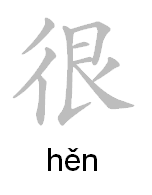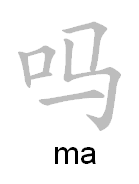Lesson One: How are you?
This first lesson begins with some simple greetings that you can use at any time of day. Grammar focuses on two common forms of asking questions. Explanations are given for writing the eight new characters taught in this lesson.
Conversation: 你好吗?
你好吗?
How are you?
我很好。谢谢。
I am fine, thank you.
你呢?
And you?
我也很好。
I am fine too.
| New Words | ||
|---|---|---|
| 你 | pron. (singular) you | |
| 我 | pron. I, me, self |
|
| 好 | adj. good, fine |
|
| 很 | adv. very, quite, very much | |
| 也 | adv. also; too |
|
| 谢 | vb. thanks, thank you |
|
| 吗 | pt. (question form used at the end of sentence) | |
| 呢 | pt. (for questions on a subject under consideration) |
Correct Usage
你好 is the most common greeting and can be used at any time of day.
您 is a polite usage of 你 that is used to show respect when addressing elders.
Grammar Points
Asking questions with 吗
There are many forms for interrogative sentences in Chinese. One of the most common is to add 吗 to the end of a sentence. It is not necessary to change the word order of the sentence.
Asking questions with 呢
Another form of interrogative sentence in Chinese is to add 呢 after the noun and pronoun. 你呢? is similar to “And you?” in English.
Exercises
Read the following phrases and translate them into English.
- 你好吗?
- 我很好.
- 你呢?
- 谢谢.
Writing Exercises
If possible use paper with squares on it. Remember each character should appear as if it is inside a square without touching the edges of the square. Refer to the writing basics lesson if you are unsure of the different strokes.


This concludes the first lesson. You should now be familiar with 7 different Chinese characters and be able to make several sentences using them. Read over this lesson’s contents as many times as necessary until you feel you have mastered all the material.

August 4, 2017 @ 8:08 am
Awesome! This website makes learning this way easier and simpler than the traditional text books and writing!
March 27, 2017 @ 3:12 pm
At 66, im so happy to learn Mandarin Chinese. I am Irish and many non Irish people think our language is very complicated and hard to write.
Your website seems to dispel that myth, and I hope that one day i can exchange ideas in speech and the written word between our two cultures.
January 19, 2017 @ 10:00 am
Hi,I am intersted to learning mandarin.:)
November 16, 2016 @ 4:47 pm
Thanks to the creator! <3
October 27, 2016 @ 7:16 pm
I hope I will be fluent in Chinese, some day.
October 10, 2016 @ 2:37 pm
am so excited to find this website, i love chinese